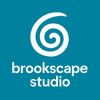Lately, I’ve been pushing my cyanotype experiments beyond the usual safe papers. Some trials (all pictured above) were clear busts—Tyvek refused to hold the chemistry and never even turned blue, and delicate rice paper disintegrated on contact.
High-quality printer paper (normally great for gel prints) also failed spectacularly, nearly falling apart in the wash and refusing to hold the chemistry.
Brown kraft paper gave me only “meh” results—its warm tone dulled the blue, and the lack of contrast made the images flat.

Reliable standbys like Strathmore and Canson Bristol (both vellum and smooth) delivered their usual crisp, rich prints. I also tried more unpredictable surfaces: a thrifted pad of old sketch paper and pages from a vintage French book. Both are acidic, and the chemistry grabbed at the fibers in unusual ways, creating moody, textured effects I love.
I even tried a cloudy-day exposure—beautiful results, just needed two to three extra minutes in the light. Sometimes the best discoveries come from breaking the “rules.”


0 comments